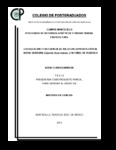| dc.description.abstract | Con la finalidad de conocer la respuesta del nopal verdura a la fertilización orgánica y química, incluyendo la inoculación de un hongo micorrícico y la frecuencia de riego, bajo condiciones de túnel de plástico. De 2010 a 2011 se evaluó el rendimiento y los parámetros de calidad: índice de color, pH, acidez titulable, textura, contenido de fibra y concentración nutrimental. Además de cuantificar el consumo de agua en una plantación de nopal verdura (Opuntia ficus indica L.). Para ello se utilizó un diseño experimental de parcelas divididas, donde en la parcela grande se estudió la frecuencia de riego cuando la tensión en el suelo era de 35 y 70 cb, y en la parcela dividida la fuente de fertilización (composta, inoculación del hongo micorrícico Glomus mosseae, fertirriego, composta más inoculación, composta más urea y superfosfato de calcio triple, estiércol y triple 17) y un testigo. En rendimiento el efecto estuvo dado por la fuente de fertilización, siendo el de mayor rendimiento el tratamiento estiércol y triple 17 (266 t ha-1). Con relación a índice de color, acidez titulable, contenido de fibra soluble e insoluble y concentración nutrimental en el cladodio, la respuesta fue significativa por la interacción de los dos factores estudiados. Los tratamientos sobresalientes fueron estiércol más triple 17, composta más superfosfato de calcio triple y fertirriego con la mayor frecuencia de riego (4 riegos mes-1). Con una anual de 392 mm y una lámina diaria de 1.1mm. _______________ FERTILIZATION AND IRRIGATION FREQUENCY IN VEGETABLE PRODUCTION PRICKLY PEAR (Opuntia ficus indica L.) IN PLASTIC TUNNEL. ABSTRACT: In order to know the prickly pear response to organic and chemical fertilization, including inoculation of mycorrhizal fungi and frequency of irrigation under plastic tunnel conditions. From 2010-2011 we evaluated the performance and quality parameters: color index, pH, titratable acidity, texture, fiber content and nutrient concentration. In addition to quantifying water consumption in a plantation of prickly pear (Opuntia ficus indica L.). To do this we used a split-plot experimental design, where the main plot was examined irrigation frequency when the voltage on the ground was 35 and 70 cb, and the split-plot fertilization source (compost, inoculation of the fungus mycorrhizal Glomus mosseae, fertigation, more inoculation compost, compost plus urea and triple calcium superphosphate, triple-manure and 17) and a control. In performance the effect was given by the fertilizer source, being the highest performing triple-manure treatment 17 (266 t ha-1). Ratio relative to color, acidity, content of soluble and insoluble fiber and nutrient concentration in the cladode significant responses by interaction of the two factors studied. The treatments were manure plus triple outstanding 17 compost more triple calcium superphosphate and as often fertigation irrigation (4 irrigations month-1). With an annual laminated sheet 392 mm and 1.1mm daily. | en_US |


